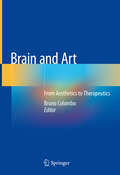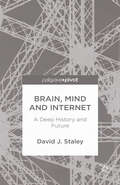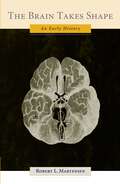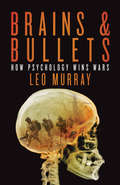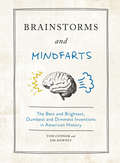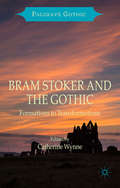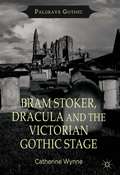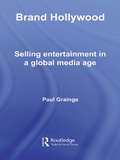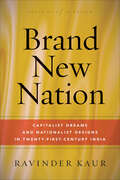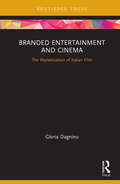- Table View
- List View
Brain and Art: From Aesthetics to Therapeutics
by Bruno ColomboThis book analyzes and discusses in detail art therapy, a specific tool used to sustain health in affective developments, rehabilitation, motor skills and cognitive functions. Art therapy is based on the assumption that the process of making art (music, dance, painting) sparks emotions and enhances brain activity. Art therapy is used to encourage personal growth, facilitate particular brain areas or activity patterns, and improve neural connectivity. Treating neurological diseases using artistic strategies offers us a unique option for engaging brain structural networks that enhance the brain’s ability to form new connections. Based on brain plasticity, art therapy has the potential to increase our repertoire for treating neurological diseases. Neural substrates are the basis of complex emotions relative to art experiences, and involve a widespread activation of cognitive and motor systems. Accordingly, art therapy has the capacity to modulate behavior, cognition, attention and movement. In this context, art therapy can offer effective tools for improving general well-being, quality of life and motivation in connection with neurological diseases. The book discusses art therapy as a potential group of techniques for the treatment of neurological disturbances and approaches the relationship between humanistic disciplines and neurology from a holistic perspective, reflecting the growing interest in this interconnection.
Brain Electricity: The Interwoven History of Electricity and Neuroscience
by Robert W. BalohThis book traces the intertwining story of electricity and neuroscience from ancient times to the late 20th century. Throughout the book, basic concepts of electricity, electromagnetism, and neuroscience are addressed and illustrated. It is replete with remarkable discoveries and colorful characters that dramatically changed human culture. Electricity and neuroscience are topics that have fascinated science historians for centuries. Yet, it has only been over the past several decades that medical science historians have appreciated the close interrelationship of these two topics. Robert Baloh uses a historical context of discovery to provide an ideal framework for understanding modern concepts of electricity and neuroscience. The stories of these pioneering researchers can be inspirational for those beginning a career in neuroscience as well as for more experienced researchers.
Brain Imaging: The Chemistry of Mental Activity
by Henry N. WagnerThis book describes what molecular imaging is, how it developed, what are its basic principles, and what it has told us and can tell us about the chemistry of the human brain. Everyone today is conscious of the fact that there is chemistry going on in the brain, and that it is affected by widely used pharmaceuticals and illicit drugs. This book will elucidate these topics in an interesting, historical and philosophical way. The book is a valuable reference resource for all those in nuclear medicine and radiology as well the educated general public.
The Brain Masters of Vienna: Psychology and Neuroscience Pioneers around the Secession up to the Anschluss
by Lazaros C. TriarhouThe book comprises biographical notes, of about 1000 words each, with a portrait photo, of 90 influential figures of the famous prewar Viennese school of neuropsychiatry, appearing together for the first time in a single volume. The entries focus on the academic lives and scientific contributions of pioneers in the neurological sciences viewed from a modern perspective. These updated profiles are based on substantial new research. The book includes a wide range of people, some famous Nobel laureates, and others less well known, from the era when Vienna was the epicenter of brain research. Despite the tragic circumstances of two World Wars, these pioneers remained resilient, willing to help others with an admirable dignity against adversity that leaves an indelible lesson to the later generations. Some fell victim of the Holocaust. Others overcame the constraints of National Socialism and ultimately settled overseas to nurture their ambitions and pursue their intellectual goals as physicians, researchers, and teachers. The monograph is a useful source for scholars interested in the evolution of ideas in basic neuroscience, clinical neurology, and neuropsychiatry, and the investigators who effected them.
Brain, Mind and Internet: A Deep History and Future
by D. StaleyThis essay places the emerging brain-Internet interface within a broad historical context: that the Internet represents merely the next stage in a very long history of human cognition whereby the brain couples with symbolic technologies. Understanding this 'deep history' provides a way to imagine the future of brain-Internet cognition.
Brain, Mind and Medicine: Essays in Eighteenth-Century Neuroscience
by Harry Whitaker C. U. M. Smith Stanley FingerNo books have been published on the practice of neuroscience in the eighteenth century, a time of transition and discovery in science and medicine. This volume explores neuroscience and reviews developments in anatomy, physiology, and medicine in the era some call the Age of Reason, and others the Enlightenment. Topics include how neuroscience adopted electricity as the nerve force, how disorders such as aphasia and hysteria were treated, Mesmerism, and more.
The Brain Takes Shape: An Early History
by Robert L. MartensenUsing historical and anthropological perspectives to examine mind-body relationships in western thought, this book interweaves topics that are usually disconnected to tell a big, important story in the histories of medicine, science, philosophy, religion, and political rhetoric. Beginning with early debates during the Scientific Revolution about representation and reality, Martensen demonstrates how investigators such as Vesalius and Harvey sought to transform long-standing notions of the body as dominated by spirit-like humors into portrayals that emphasized its solid tissues. Subsequently, Descartes and Willis and their followers amended this 'new' philosophy to argue for the primacy of the cerebral hemispheres and cranial nerves as they downplayed the role of the spirit, passion, and the heart in human thought and behavior. None of this occurred in a social vacuum, and the book places these medical and philosophical innovations in the context of the religious and political crises of the Reformation and English Civil War and its aftermath. Patrons and their interests are part of the story, as are patients and new formulations of gender. John Locke's psychology and the emergence in England of a constitutional monarchy figure prominently, as do opponents of the new doctrines of brain and nerves and the emergent social order. The book's concluding chapter discusses how debates over investigative methods and models of body order that first raged over 300 years ago continue to influence biomedicine and the broader culture today. No other book on western mind-body relationships has attempted this.
Brains & Bullets: How psychology wins wars
by Leo MurrayThis book is the story of how Western armies forgot how to fight real people. It is not about generals and strategies; it is focused on small groups of men in desperate situations and how they use their brains and their bullets to make the enemy surrender.' The closer people get to war the less they like it. The human brain is hard-wired with a primal, almost imperceptible aversion to killing and an intense aversion to being killed. In order to win wars, vast effort and uncountable sums have been expended to try and quash these reactions in our soldiers. For years, this research focused on two questions: 'Who fights?' and 'How can we make more people fight?' In Brains & Bullets, military psychologist Leo Murray argues that, given the right conditions, everybody fights. Change those conditions, however, and almost everybody will stop fighting. If we really want to win wars, the question we ought to be asking is: 'How do we make the enemy stop fighting?' Interweaving intense first-hand accounts of combat with the hard science of tactical psychology, this extensively researched study offers a fascinating insight into what war does to the human mind. Most crucially, it also suggests a new way to approach military conflict - one which comes too late to change the outcome of the war in Afghanistan, but which may well have a profound effect on the future of modern warfare.
Brainstorms and Mindfarts: The Best and Brightest, Dumbest and Dimmest Inventions in American History
by Tom Connor Jim DowneyThis informative and occasionally bizarre collection of American inventions will help you discover successful and significant ideas—along with the frivolous and utterly useless ones lost to history. Innovation and entrepreneurism appear inextricably woven into the American DNA. Throughout American history, the great inventors and innovators gazed into the future and saw the products and services that would transform the world. While passionate about creating this new thing called a democracy, our Founding Fathers were also driven to change the way humans lived and worked—to complete everyday tasks faster, easier, and more efficiently.As of 2018, the U.S. Patent & Trademark Office had granted its ten millionth patent. But with over 500,000 applications now being filed annually, fewer than half of these applicants will be granted patents and far fewer still—an estimated one percent—will realize commercial success, according to the Office. Some are flawed by mistakes or missing details, others too ridiculous to take seriously, still others simply ahead of their time.From the brightest and most innovative to the wackiest, most bizarre, and downright crazy, this collection of 100 patents includes funny and informative descriptions and original illustrations, all the while letting you in on what most successful patents have in common, what inspired their creators, and how great inventors view the world.
Brainwaves: A Cultural History Of Electroencephalography (Science, Technology and Culture, 1700-1945)
by Cornelius BorckIn the history of brain research, the prospect of visualizing brain processes has continually awakened great expectations. In this study, Cornelius Borck focuses on a recording technique developed by the German physiologist Hans Berger to register electric brain currents; a technique that was expected to allow the brain to write in its own language, and which would reveal the way the brain worked. Borck traces the numerous contradictory interpretations of electroencephalography, from Berger’s experiments and his publication of the first human EEG in 1929, to its international proliferation and consolidation as a clinical diagnostic method in the mid-twentieth century. Borck's thesis is that the language of the brain takes on specific contours depending on the local investigative cultures, from whose conflicting views emerged a new scientific object: the electric brain.
Brainwaves: A Cultural History of Electroencephalography (Science, Technology and Culture, 1700-1945)
by Cornelius BorckIn the history of brain research, the prospect of visualizing brain processes has continually awakened great expectations. In this study, Cornelius Borck focuses on a recording technique developed by the German physiologist Hans Berger to register electric brain currents; a technique that was expected to allow the brain to write in its own language, and which would reveal the way the brain worked. Borck traces the numerous contradictory interpretations of electroencephalography, from Berger’s experiments and his publication of the first human EEG in 1929, to its international proliferation and consolidation as a clinical diagnostic method in the mid-twentieth century. Borck's thesis is that the language of the brain takes on specific contours depending on the local investigative cultures, from whose conflicting views emerged a new scientific object: the electric brain.
Bram Stoker: History, Psychoanalysis and the Gothic
by Andrew Smith William HughesStoker is best remembered today as the author of Dracula . However, as the twelve essays in this volume demonstrate, Stoker's work blends the Gothic with the discourses of politics, sexuality, medicine and national identity to produce texts that may be read by a variety of critical methodologies. Following an Introduction that analyses how Stoker's writings have been critically received in the twentieth century, the book addresses not merely Dracula but also the author's other writings through historicism, psychology and genre.
Bram Stoker and the Gothic: Formations to Transformations (Palgrave Gothic)
by Catherine Wynne'My revenge is just begun! I spread it over centuries, and time is on my side,' warns Dracula. This statement is descriptive of the Gothic genre. Like the Count, the Gothic encompasses and has manifested itself in many forms. Bram Stoker and the Gothic demonstrates how Dracula marks a key moment in the transformation of the Gothic. Harking back to early Gothic's preoccupation with the supernatural, decayed aristocracy and incarceration in gloomy castles, the novel speaks to its own time, but has also transformed the genre, a revitalization that continues to sustain the Gothic today. This collection explores the formations of the Gothic, the relationship between Stoker's work and some of his Gothic predecessors, such as Poe and Wollstonecraft, presents new readings of Stoker's fiction and probes the influences of his cultural circle, before concluding by examining aspects of Gothic transformation from Daphne du Maurier to Stoker's own 'reincarnation' in fiction and biography. Bram Stoker and the Gothic testifies to Stoker's centrality to the Gothic genre. Like Dracula, Stoker's 'revenge' shows no sign of abating.
Bram Stoker, Dracula and the Victorian Gothic Stage (Palgrave Gothic)
by C. WynneBram Stoker, Dracula and the Victorian Gothic Stage re-appraises Stoker's key fictions in relation to his working life. It takes Stoker's work from the margins to centre stage, exploring how Victorian theatre's melodramatic and Gothic productions influenced his writing and thinking.
Brand Hollywood: Selling Entertainment in a Global Media Age
by Paul GraingeFrom the growth in merchandising and product placement to the rise of the movie franchise, branding has become central to the modern blockbuster economy. In a wide-ranging analysis focusing on companies such as Disney, Dolby, Paramount, New Line and, in particular, Warner Bros., Brand Hollywood provides the first sustained examination of the will-to-brand in the contemporary movie business. Outlining changes in the marketing and media environment during the 1990s and 2000s, Paul Grainge explores how the logic of branding has propelled specific kinds of approach to the status and selling of film. Analyzing the practice of branding, the poetics of corporate logos, and the industrial politics surrounding the development of branded texts, properties and spaces - including franchises ranging from Looney Tunes to Lord of the Rings and Harry Potter to The Matrix - Grainge considers the relation of branding to the emergent principle of ‘total entertainment’. Employing an interdisciplinary method drawn from film studies, cultural studies and advertising and media studies, Brand Hollywood demonstrates the complexities of selling entertainment in the global media moment, providing a fresh and engaging perspective on branding’s significance for commercial film and the industrial culture from which it is produced.
Brand Hollywood: Selling Entertainment in a Global Media Age
by Paul GraingeFrom the growth in merchandising and product placement to the rise of the movie franchise, branding has become central to the modern blockbuster economy. In a wide-ranging analysis focusing on companies such as Disney, Dolby, Paramount, New Line and, in particular, Warner Bros., Brand Hollywood provides the first sustained examination of the will-to-brand in the contemporary movie business. Outlining changes in the marketing and media environment during the 1990s and 2000s, Paul Grainge explores how the logic of branding has propelled specific kinds of approach to the status and selling of film. Analyzing the practice of branding, the poetics of corporate logos, and the industrial politics surrounding the development of branded texts, properties and spaces - including franchises ranging from Looney Tunes to Lord of the Rings and Harry Potter to The Matrix - Grainge considers the relation of branding to the emergent principle of ‘total entertainment’. Employing an interdisciplinary method drawn from film studies, cultural studies and advertising and media studies, Brand Hollywood demonstrates the complexities of selling entertainment in the global media moment, providing a fresh and engaging perspective on branding’s significance for commercial film and the industrial culture from which it is produced.
Brand New Nation: Capitalist Dreams and Nationalist Designs in Twenty-First-Century India (South Asia in Motion)
by Ravinder KaurA Financial Times Best Book of the Year The first book that examines India's mega-publicity campaigns to theorize the global transformation of the nation-state into an attractive investment destination. The early twenty-first century was an optimistic moment of global futures-making. The chief narrative was the emergence of the BRICS nations—leading stars in the great spectacle of capitalist growth stories, branded afresh as resource-rich hubs of untapped talent and potential, and newly opened up for foreign investments. The old third-world nations were rapidly embracing the script of unbridled capitalism in the hope of arriving on the world stage. If the tantalizing promise of economic growth invited entrepreneurs to invest in the nation's exciting futures, it offered utopian visions of "good times," and even restoration of lost national glory, to the nation's citizens. Brand New Nation reaches into the past and, inevitably, the future of this phenomenon as well as the fundamental shifts it has wrought in our understanding of the nation-state. It reveals the on-the-ground experience of the relentless transformation of the nation-state into an "attractive investment destination" for global capital. As Ravinder Kaur provocatively argues, the brand new nation is not a mere nineteenth century re-run. It has come alive as a unified enclosure of capitalist growth and nationalist desire in the twenty-first century. Today, to be deemed an attractive nation-brand in the global economy is to be affirmed as a proper nation. The infusion of capital not only rejuvenates the nation; it also produces investment-fueled nationalism, a populist energy that can be turned into a powerful instrument of coercion. Grounded in the history of modern India, the book reveals the close kinship among identity economy and identity politics, publicity and populism, and violence and economic growth rapidly rearranging the liberal political order the world over.
Branded Beauty: How Marketing Changed the Way We Look
by Mark TungateBeauty is a multi-billion dollar global industry embracing make-up, skincare, hair care, fragrances, cosmetic surgery - even tattooing and piercing. Over the years it has used flattery, seduction, science and shame to persuade consumers to invest if they want to look their best. Branded Beauty delves into the history and evolution of the beauty business. From luxury boutiques in Paris to tattoo parlours in Brooklyn, it contains interviews with the people who've made skin their trade. Analyzing the marketing strategies used by those who create and sell beauty products, it visits the labs where researchers seek the key to eternal youth. It compares attitudes to beauty from around the world and examines the rise of organic beauty products. Full of fascinating detail from great names such as Rubinstein and Arden, Revlon, Estée Lauder, L'Oréal and Max Factor, Branded Beauty is the ultimate guide to the current state of the industry and what the future holds for the beauty business.
Branded Beauty: How Marketing Changed the Way We Look
by Mark TungateBeauty is a multi-billion dollar global industry embracing make-up, skincare, hair care, fragrances, cosmetic surgery - even tattooing and piercing. Over the years it has used flattery, seduction, science and shame to persuade consumers to invest if they want to look their best. Branded Beauty delves into the history and evolution of the beauty business. From luxury boutiques in Paris to tattoo parlours in Brooklyn, it contains interviews with the people who've made skin their trade. Analyzing the marketing strategies used by those who create and sell beauty products, it visits the labs where researchers seek the key to eternal youth. It compares attitudes to beauty from around the world and examines the rise of organic beauty products. Full of fascinating detail from great names such as Rubinstein and Arden, Revlon, Estée Lauder, L'Oréal and Max Factor, Branded Beauty is the ultimate guide to the current state of the industry and what the future holds for the beauty business.
Branded Entertainment and Cinema: The Marketisation of Italian Film (Routledge Critical Advertising Studies)
by Gloria DagninoThe history of Italian cinema is mostly regarded as a history of Italian auteurs. This book takes a different standpoint, looking at Italian cinema from the perspective of an unusual, but influential actor: advertisers. From the iconic Vespa scooter and the many other Made in Italy products placed in domestic and international features, to Carosello’s early format of branded entertainment, up through the more recent brand integration cases in award-winning titles like The Great Beauty, the Italian film and advertising industries have frequently and significantly intersected, in ways that remain largely unexplored by academic research. This book contributes to fill this gap, by focusing on the economic and cultural influence that advertising and advertisers’ interests have been exerting on Italian film production between the post-war period and the 2010s. Increasingly market-oriented film policies, ongoing pressure from Hollywood competition, and the abnormal economic as well as political power held by Italian ad-funded broadcasters are among the key points addressed by the book. In addition to a macro-level political economic analysis, the book draws on exclusive interviews with film producers and promotional intermediaries to provide a meso level analysis of the practices and professional cultures of those working at the intersection of Italian film and advertising industries. Providing an in-depth yet clear and accessible overview of the political and economic dynamics driving the Italian media landscape towards unprecedented forms of marketisation, this is a valuable resource for academics and students in the fields of film and media studies, marketing, advertising, and Italian studies.
Branded Entertainment and Cinema: The Marketisation of Italian Film (Routledge Critical Advertising Studies)
by Gloria DagninoThe history of Italian cinema is mostly regarded as a history of Italian auteurs. This book takes a different standpoint, looking at Italian cinema from the perspective of an unusual, but influential actor: advertisers. From the iconic Vespa scooter and the many other Made in Italy products placed in domestic and international features, to Carosello’s early format of branded entertainment, up through the more recent brand integration cases in award-winning titles like The Great Beauty, the Italian film and advertising industries have frequently and significantly intersected, in ways that remain largely unexplored by academic research. This book contributes to fill this gap, by focusing on the economic and cultural influence that advertising and advertisers’ interests have been exerting on Italian film production between the post-war period and the 2010s. Increasingly market-oriented film policies, ongoing pressure from Hollywood competition, and the abnormal economic as well as political power held by Italian ad-funded broadcasters are among the key points addressed by the book. In addition to a macro-level political economic analysis, the book draws on exclusive interviews with film producers and promotional intermediaries to provide a meso level analysis of the practices and professional cultures of those working at the intersection of Italian film and advertising industries. Providing an in-depth yet clear and accessible overview of the political and economic dynamics driving the Italian media landscape towards unprecedented forms of marketisation, this is a valuable resource for academics and students in the fields of film and media studies, marketing, advertising, and Italian studies.
Branded Hearts (Mills And Boon Vintage 90s Modern Ser.)
by Diana HallKIT O'SHANE WOULD NEVER SURRENDER Her quest for justice came before any chance at love, even if that chance was with rancher Garret Blaine, a man she wanted with a wildfire intensity that rivaled the desert sun!
Brandenburg-Prussia, 1466-1806: The Rise of a Composite State (Studies in European History)
by Karin FriedrichKarin Friedrich locates the composite state of Brandenburg-Prussia in its historical, political, religious and economic context, from the demise of the Teutonic Knights in the fifteenth century to the Napoleonic crisis. Synthesising debates in German, English and Polish historical writing, the study focuses on key themes and concepts such as:• confessionalisation, state-building, absolutism, and the rural economy• the primacy of foreign politics• the impact of an enlightened public sphere on changing notions of citizenship.Friedrich assesses the ability of the Prussian state to integrate its constituent parts, not least by creating a patriotic identity and notion of unity under the name of 'Prussia'. Challenging myths and older views, this fresh interpretation is ideal for anyone studying this complex political entity within early modern Europe.
